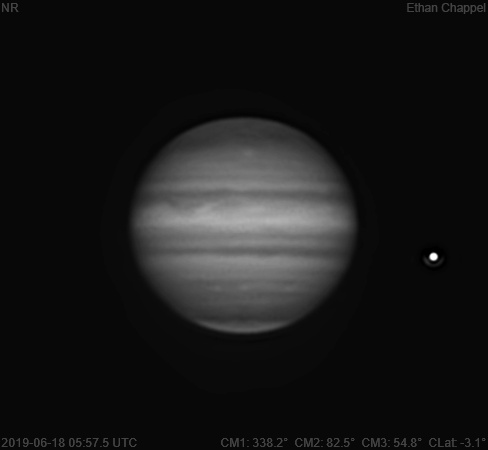
Jupiter UTC
CM1: 338.20°
CM2: 82.50°
CM3: 54.80°
CLat: -3.10°
Description
To round out Jupiter imaging for the night, I decided to capture a methane image to reveal the altitude of clouds.
Notes:
- There is a bright spot on the central meridian at mid-northern latitudes. As far as I can tell, this spot is almost indistinguishable in visible light and faintly outlined in deep-red/infrared.
- The southern edge of the Equatorial Zone is darker than the rest.
- The South Equatorial Belt is split by a zone.
Equipment
ZWO ASI290MM
Celestron EdgeHD 8
Logs
FireCapture v2.6 Settings ------------------------------------ Observer=Ethan Chappel Camera=ZWO ASI290MM Filter=CH4 Profile=Jupiter Diameter=45.90" Magnitude=-2.61 CMI=338.1° CMII=82.4° CMIII=54.7° (during mid of capture) FocalLength=1650mm (F/5) Resolution=0.37" Filename=2019-06-18-0557_5-EC-CH4-Jup.ser Date=2019_06_18 Start=05_55_30.395 Mid=05_57_30.398 End=05_59_30.401 Start(UT)=05_55_30.395 Mid(UT)=05_57_30.398 End(UT)=05_59_30.401 Duration=240.006s Date_format=yyyy_MM_dd Time_format=HH_mm_ss LT=UT -6h Frames captured=4799 File type=SER Binning=no Bit depth=8bit Debayer=no ROI=412x294 ROI(Offset)=0x0 FPS (avg.)=19 Shutter=50.00ms Gain=450 (75%) Brightness=1 (off) AutoGain=off USBTraffic=40 (off) HighSpeed=off Gamma=50 AutoHisto=75 (off) SoftwareGain=10 (off) FPS=100 (off) AutoExposure=off Histogramm(min)=0 Histogramm(max)=255 Histogramm=100% Noise(avg.deviation)=3.58 AutoAlign=false PreFilter=none Limit=240 Seconds Sensor temperature=31.6°C